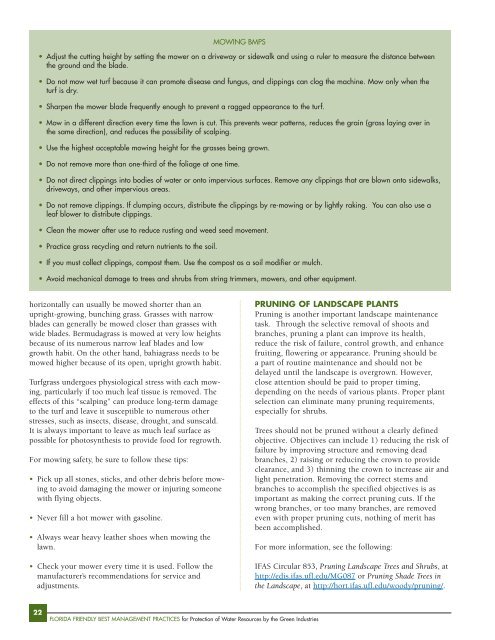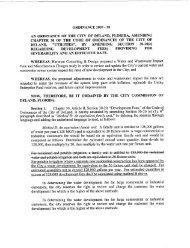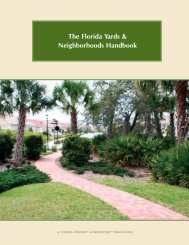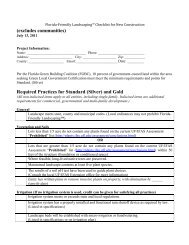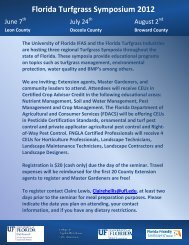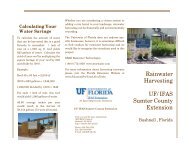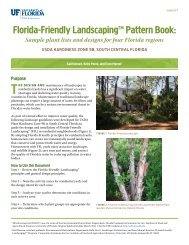MOWING BMPS• Adjust the cutting height by setting the mower on a driveway or sidewalk and using a ruler to measure the distance betweenthe ground and the blade.• Do not mow wet turf because it can promote disease and fungus, and clippings can clog the machine. Mow only when theturf is dry.• Sharpen the mower blade frequently enough to prevent a ragged appearance to the turf.• Mow in a different direction every time the lawn is cut. This prevents wear patterns, reduces the grain (grass laying over inthe same direction), and reduces the possibility of scalping.• Use the highest acceptable mowing height for the grasses being grown.• Do not remove more than one-third of the foliage at one time.• Do not direct clippings into bodies of water or onto impervious surfaces. Remove any clippings that are blown onto sidewalks,driveways, and other impervious areas.• Do not remove clippings. If clumping occurs, distribute the clippings by re-mowing or by lightly raking. You can also use aleaf blower to distribute clippings.• Clean the mower after use to reduce rusting and weed seed movement.• Practice grass recycling and return nutrients to the soil.• If you must collect clippings, compost them. Use the compost as a soil modifier or mulch.• Avoid mechanical damage to trees and shrubs from string trimmers, mowers, and other equipment.horizontally can usually be mowed shorter than anupright-growing, bunching grass. Grasses with narrowblades can generally be mowed closer than grasses withwide blades. Bermudagrass is mowed at very low heightsbecause of its numerous narrow leaf blades and lowgrowth habit. On the other hand, bahiagrass needs to bemowed higher because of its open, upright growth habit.Turfgrass undergoes physiological stress with each mowing,particularly if too much leaf tissue is removed. Theeffects of this “scalping” can produce long-term damageto the turf and leave it susceptible to numerous otherstresses, such as insects, disease, drought, and sunscald.It is always important to leave as much leaf surface aspossible for photosynthesis to provide food for regrowth.For mowing safety, be sure to follow these tips:• Pick up all stones, sticks, and other debris before mowingto avoid damaging the mower or injuring someonewith flying objects.• Never fill a hot mower with gasoline.• Always wear heavy leather shoes when mowing thelawn.• Check your mower every time it is used. Follow themanufacturer’s recommendations for service andadjustments.PRUNING OF LANDSCAPE PLANTSPruning is another important landscape maintenancetask. Through the selective removal of shoots andbranches, pruning a plant can improve its health,reduce the risk of failure, control growth, and enhancefruiting, flowering or appearance. Pruning should bea part of routine maintenance and should not bedelayed until the landscape is overgrown. However,close attention should be paid to proper timing,depending on the needs of various plants. Proper plantselection can eliminate many pruning requirements,especially for shrubs.Trees should not be pruned without a clearly definedobjective. Objectives can include 1) reducing the risk offailure by improving structure and removing deadbranches, 2) raising or reducing the crown to provideclearance, and 3) thinning the crown to increase air andlight penetration. Removing the correct stems andbranches to accomplish the specified objectives is asimportant as making the correct pruning cuts. If thewrong branches, or too many branches, are removedeven with proper pruning cuts, nothing of merit hasbeen accomplished.For more information, see the following:IFAS Circular 853, Pruning Landscape Trees and Shrubs, athttp://edis.ifas.ufl.edu/MG087 or Pruning Shade Trees inthe Landscape, at http://hort.ifas.ufl.edu/woody/pruning/.22FLORIDA FRIENDLY BEST MANAGEMENT PRACTICES for Protection of Water Resources by the <strong>Green</strong> <strong>Industries</strong>
MANGROVESThree species of mangroves are native to Florida: redmangrove (Rhizophora mangle), black mangrove(Avicennia germinans), and white mangrove (Lagunculariaracemosa).Red mangroves are easily identified by their “prop roots,”which are tangled, reddish, aerial roots that originatefrom the trunk and branches. Their leaves are 1 to 5 incheslong, broad and blunt on the tip, shiny deep green ontop, and paler on the underside.Black mangroves can be identified by numerous fingerlikeprojections, called pneumatophores, that protrude fromthe soil around the tree’s trunk. Black mangrove leavesare oblong, shiny green on top, and very pale on theunderside. Black mangroves are usually found at slightlyhigher elevations, upland from red mangroves.White mangroves have no visible aerial root system, as dored and black mangroves. The easiest way to identifywhite mangroves is by their leaves. These are up to 3inches long, elliptical (rounded at both ends, often with anotch at the tip), and yellowish in color, with two distinguishingglands at the base of each leaf blade where thestem begins. White mangroves are usually found at higherelevations and farther upland than either red or blackmangroves.The 1996 Mangrove Trimming and Preservation Act,Sections 403.9321-403.9333, Florida Statutes, governsthe trimming and alteration of mangroves. The FloridaDepartment of Environmental Protection (FDEP) andseveral delegated local governments implement themangrove program. Mangrove trimming and alterationThe mangrove preservation act’s major provisionsinclude the following:• The difference between “trimming” and “alteration” ofmangroves is defined.• Mangroves may not be reduced to a height below 6feet from the substrate and often may not be legallytrimmed down to 6 feet.• Mangrove roots, including aerial and prop roots (redmangroves) and pneumatophores (black mangroves),may not be trimmed.• Under certain conditions, a professional mangrovetrimmer must conduct or supervise the trimming.• Dead mangrove trees are covered by the same regulationsas living mangrove trees; contact the closestFlorida Department of Environmental Protection officefor specific information on dealing with dead mangrovetrees on your client’s property.may be done by property owners under certain exemptions,as specified in Section 403.9326, Florida Statutes.Other trimming requires the services of a professionalmangrove trimmer and may require an FDEP permit.Section 403.9329, Florida Statutes, governs who may beconsidered a professional mangrove trimmer.It is especially important that <strong>Green</strong> Industry professionalsunderstand that, under the act, homeowners and theindividuals they hire to trim their mangroves are jointlyand severally responsible for the appropriate trimmingof mangroves.All trimming should be done in a manner that doesnot result in the removal, defoliation, or death of themangroves. Red mangroves are particularly sensitive toinappropriate trimming. In general, the canopy of redmangroves should not be trimmed, and no more than25 percent of the canopy of black and white mangrovesshould be removed. Preferably, views should be obtainedby thinning the canopy, creating “windows,” and “uplifting,”compared with hedging (which can be particularlydamaging to red mangroves).• The booklet Mangrove Trimming Guidelines forHomeowners is available at FDEP’s district officesthroughout the state. You may wish to obtain severalcopies to give your clients. Before trimming mangroves,homeowners and landscapers should readthe publications cited in this section, or call theEnvironmental Resource Permitting staff at FDEP’sdistrict offices to avoid violating the mangrovepreservation act.For more information about the mangrove program, call(850) 245-8482 or go to http://www.dep.state.fl.us/water/wetlands/mangroves/.DISPOSING OF LANDSCAPE MATERIALNever sweep grass clippings, leaves, or other debrisinto a storm sewer. This pollutes our waterbodies andmay, in some cases, clog the system and contribute toflooding.Be careful with yard waste! Careless disposal may spreadinvasive non-native plants to areas where they don’tbelong. Lawn and landscape maintenance involves theremoval of leaves, clippings, whole landscape plants, andeven unwanted houseplants. Given contact with soil andsufficient water, these materials may become establishedat the disposal site. Dispose of them carefully, so plantsthat are unwanted in one location don’t unintentionallybecome established elsewhere. Contact your countywaste management utility or Cooperative ExtensionService agent for information about local disposal sites inyour area that are designated for plant waste. Educateyour customers about proper plant disposal and how itenhances the protection of natural areas.Department of Environmental Protection – Revised DECEMBER 200823
- Page 3 and 4: GOALS OF THE MANUALThis manual prov
- Page 5 and 6: Table of ContentsGOALS OF THE MANUA
- Page 7 and 8: Chapter 1: IntroductionUSING BEST M
- Page 9 and 10: these is performed properly, the ne
- Page 11: BMPs, job safety, and the specific
- Page 14 and 15: compacted by construction activity?
- Page 16 and 17: promotes deeper rooting, which is o
- Page 18 and 19: Protection, water management distri
- Page 21 and 22: IRRIGATION SYSTEM INSTALLATIONOnly
- Page 23 and 24: tion promotes deeper root developme
- Page 25 and 26: GREEN INDUSTRY IRRIGATION BMPSThe p
- Page 27: MOWING THE FLORIDA LAWNMowing is an
- Page 31 and 32: Chapter 5: FertilizationFERTILIZER
- Page 33 and 34: cases, these stabilized N materials
- Page 35 and 36: influences the activity of the soil
- Page 37 and 38: nitrogen restrictions discussed ear
- Page 39 and 40: impervious surface that drains to a
- Page 41 and 42: The P content of the fertilizer sho
- Page 43 and 44: plastic container, mix them thoroug
- Page 45 and 46: think that less fertilization is al
- Page 47 and 48: help to establish proof of proper u
- Page 49 and 50: The best way to manage pesticide st
- Page 51 and 52: Segregate herbicides, insecticides,
- Page 53 and 54: pressure, size of nozzle, and spaci
- Page 55 and 56: MANAGEMENT OF PESTS IN THE LANDSCAP
- Page 57 and 58: ReferencesUnless otherwise mentione
- Page 59 and 60: Pruning Shade Trees in the Landscap
- Page 61 and 62: APPENDIX A: IMPORTANT TELEPHONE NUM
- Page 63 and 64: APPENDIX B: FLORIDA COOPERATIVE EXT
- Page 65 and 66: APPENDIX C: RULE 5E-1.003(2) LABELI
- Page 67 and 68: EMERGENCY REPORTING TELEPHONE NUMBE


